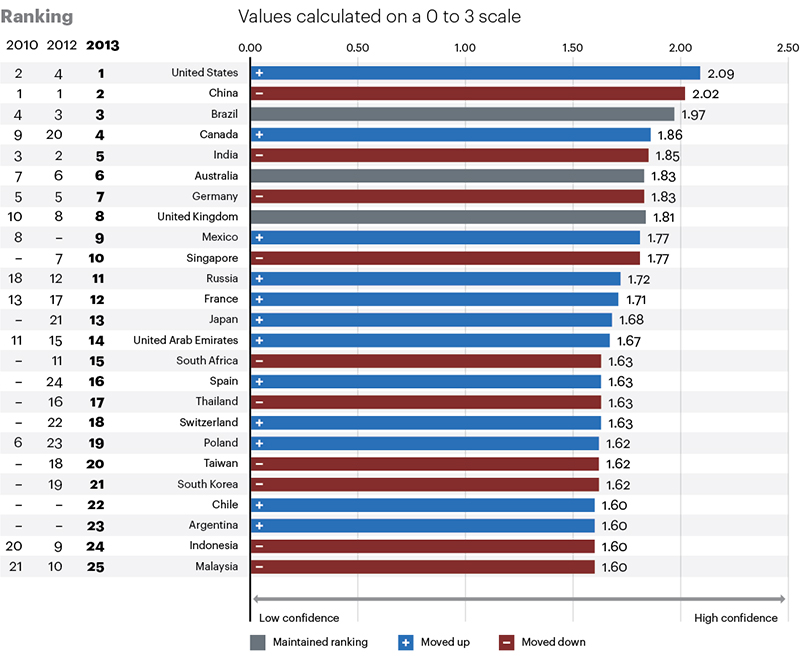América Latina: Supply Chain & Logistics Opportunities Abound, but Proceed with Care
Before entering this vibrant marketplace, trade experts advise logistics managers to conduct a very careful examination of the region’s transportation and regulatory infrastructure.
The 2013 A.T. Kearney Foreign Direct Investment Confidence Index (FDICI), a regular measure of senior executive sentiment at the world’s largest companies, indicates that Latin America remains attractive to U.S. shippers and manufacturers.
Furthermore, key emerging economies in the Americas are making a strong showing in the investment landscape this year, with Chile and Argentina joining Brazil in the top 25.
“Rather than a temporary safe haven during economic upheaval, emerging markets—particularly in Latin America—are developing into a complement, instead of an alternative, to the developed world,” notes Erik Peterson, managing director of A.T. Kearney’s Global Business Policy Council.
Brazil maintained its third place position in the FDICI this year. In 2011, its foreign direct investment (FDI) hit $66.7 billion, its highest level ever and a 37 percent increase since 2010. More inflows are likely on the way, with the 2014 World Cup and 2016 Olympics needing transportation and infrastructure investments of more than $200 billion. However, manufacturing remains the recipient of nearly half of Brazil’s FDI, with European, Scandinavian, and Chinese investors all adding billions to its economy.
2013 A.T. Kearney Foreign Direct Investment Confidence Index

But before entering this vibrant marketplace, trade experts advise logistics managers to conduct a careful examination of the region’s transportation and regulatory infrastructure. “Given sociopolitical and economic forces that seem only to be racking up new surprises each year in the region, investors in developed economies and emerging countries alike will need to find nimble strategies to deal with this shifting landscape,” says Peterson.
Infrastructure investment needed
The benefits of logistics investments in South America have been addressed recently by the Inter-American Development Bank’s Department of Infrastructure and Environment.
Jean-Paul Rodrigue, professor in the department of global studies and geography at Hofstra University, observes that transportation is an inherently crucial factor in supporting trade activities as well as providing opportunities for economic development. He argues that transport infrastructure capacity may have limited value if not supported by a proportional level of reliability and timeliness in freight distribution supported by transport services.
“Latin American and Caribbean ports have seen remarkable growth of containerized traffic handled with the development and expansion of port infrastructure,” says Rodrigue. “The conventional role of a resource exporter, such as agricultural and mining products, is being expanded through an increasing sophistication of imports and exports.”
Rodrigue says port facilities and their hinterland have responded with infrastructure investments with a well-founded anticipation of additional traffic growth. “Transport infrastructure capacity must be accompanied with freight logistics reliability, effectiveness, and resilience,” he adds.
However, Latin America’s port infrastructure is still rated “below average” by the World Bank. Channel capacity at most ports is insufficient, with productivity and berthing delays a continuing issue. And, Latin America’s exports are growing, but their share of domestic GDP is low, notes Walter Kemmsies, chief economist at the coastal and civil engineering firm Moffatt & Nichol.
“Infrastructure investment lowers costs and can raise downstream industrial exports while lowering commodity price inflation,” Kemmsies says. “The Panama Canal expansion and other infrastructure are needed to raise the share of contribution and global economic activity.”
Big 3: Brazil, Chile, Argentina
Mallory Alexander International Logistics, a global 3PL with corporate headquarters in Memphis, has examined the relative strengths and weaknesses of the transport networks in the three major South American trading nations.
Brazil strongly depends on the highway system, with more than 56 percent of its freight moving on its highways per annum. But according to B. Lee Mallory, the 3PL’s, executive vice president, only 26 percent of the highways are in excellent or good condition.
“Concentration of rail in the country is in Sao Paulo, Minas Gerais, and Rio Grande do Sul,” observes Mallory. “This mode is used chiefly to move raw materials, but increased privatization and expansion of rail will alter this significantly.”
Ocean cargo shipping is clearly destined to grow exponentially in Brazil, as it currently represents only 1 percent of total cargo moved in the country. For that to happen quickly depends on how fast new road access to harbors and warehousing can be achieved. Air cargo, too, is expected to ramp up, say analysts, especially now that a new regulatory agency—Agencia Nacional de Aviacao Civil—has been created.
One of the chief barriers to entry, however, may not be related to sea or air freight transportation. Regulatory restrictions are often the greatest challenge, say logistics leaders. “The best markets, such as Brazil, still put big obstacles in high bureaucratic institutions with complex tax structures,” says Jaime Cabrera, vice president, Latin America for ICAT Logistics, a global, agency-based freight forwarder.
Gustavo Paschoa, sales, marketing, and engineering director for Penske Logistics in South America, agrees with Cabrera, but says Brazil is seeing improvement. “At the end of last year, a new law for drivers was implemented that improved regulations and benefits,” says Paschoa. “This is an essential law in Brazil, especially in the long term. But in the short-term, it’s been a great adjustment for shippers, increasing transportation costs even further.”
Because Brazil is a member of the regional trade agreement known as Mercosur, any bilateral deal must affect all countries in this trade community, notes Paschoa. Even without this regional trade agreement, he says, Brazil has created a good environment for U.S. shippers to start their operations there.
“Large companies from the U.S., Europe, and Asia are announcing new facilities and assembly lines in Brazil, with the objective of entering our market and providing services and goods for the entire South American region using the near-sourcing concept to create more flexibility and competitiveness in the region,” says Paschoa.
Chile, meanwhile, enjoys a high level of foreign trade, with exports accounting for 40 percent of GDP. Furthermore, the nation claims to have more bilateral or regional trade agreements than any other country in the region. Due to heavy government regulation, however, analysts say that there are still some significant barriers to international competitiveness. “The railroads in Chile, for example, remain under state control,” says Mallory. “Ports, too, are owned by the state, but with recent changes in the law, there are now 10 independent companies that are fully responsible for management, development, financial administration, and assets.”
Highway networks in Chile remain fragmented, though most roads are well maintained. And due to the country’s mountainous geography, aviation is very important. Chile has 370 useable airports, but only 62 have paved runways. “The need for increased professionalization and more efficient technology has been identified as the challenge for the industry,” Mallory adds.
Argentina has a solid infrastructure system in comparison with other Latin American nations, but many areas need significant improvement. For example, the majority of Argentine roads are two-lane national and provincial routes. At the same time, Argentine rail lines have not been well maintained over the past several decades, with many key segments inoperable today.
“Despite these challenges, Argentina’s rail freight traffic has increased by more than 10 percent in each of the past five years,” says Mallory. “As a result of improved utilization and efficiencies, the cost of rail transportation has dropped by 25 percent.”
Most of Argentina’s major ports are located on the Atlantic coast, with little freight transported along the domestic waterways. Air cargo represents only 1 percent of the total cargo transported in the country, although that may change if the government is successful in privatizing some of the nation’s 142 airports. So far, only 33 major airports have been turned over to private companies to operate.
Edgar Blanco, research director at the MIT Center for Transportation and Logistics, says Argentina’s government has other issues on its plate, however. “The macro-economic climate in this country is still in bad shape,” he says. “It’s good to see that transportation infrastructure is finally getting the attention it deserves, but there are bigger political issues to resolve before U.S. shippers will do much more business there.”

More on Latin America
- A Renewed Look at Doing Business in Latin America
- América Latina: Opportunities Abound, but Proceed with Care
- Focus on Latin America: Transportation and Regulatory Infrastructure
- Focus on Latin America: Brazil, Argentina, Chile
- Focus on Latin America: The Seaborne Advantage
- Doing Business 2014: Latin America (paper)













